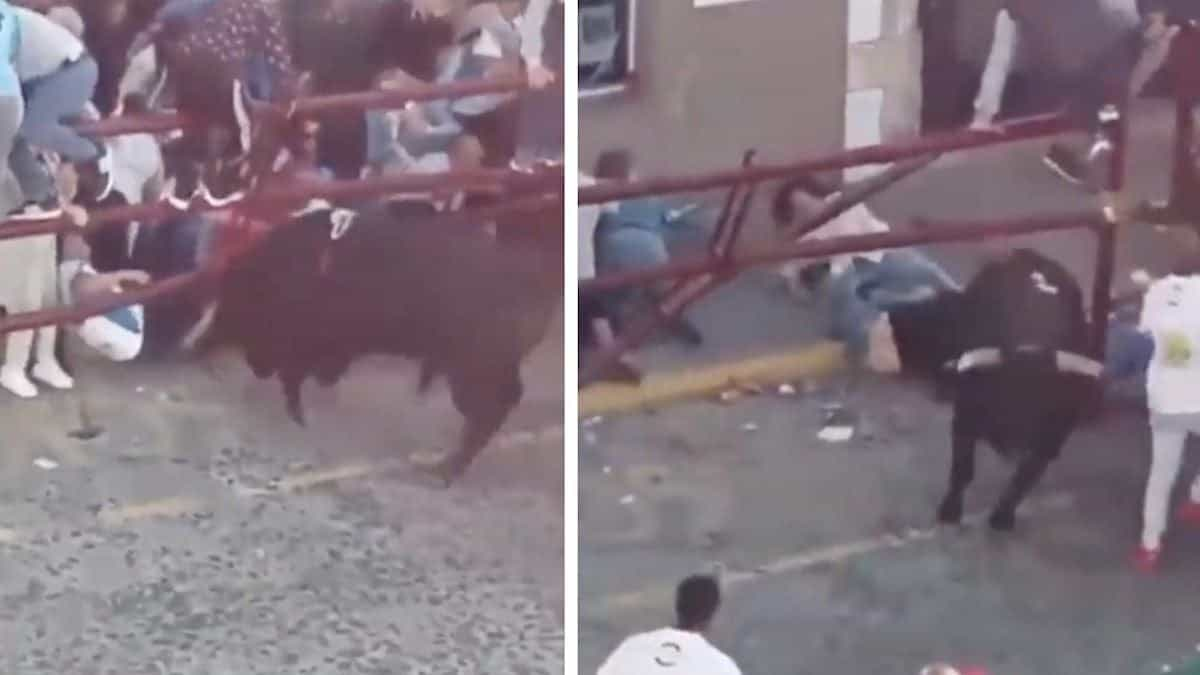Show table of content Hide table of content
In a terrifying incident that unfolded in Andalusia, Spain, a massive bull weighing over 500 kg broke through safety barriers and charged into a crowd of spectators. The event, which took place on April 19, 2025, in the picturesque town of Arcos de la Frontera, quickly transformed from a traditional celebration into a scene of panic and chaos. Such incidents remind us of the unpredictable nature of dangerous animals and the risk they can pose when containment measures fail.
Chaos unleashed during traditional Spanish festival
What began as a festive atmosphere during a traditional bull-running event in Arcos de la Frontera rapidly descended into pandemonium when a 570-kilogram bull crashed through protective barriers designed to keep spectators safe. The powerful animal, participating in the town’s annual feria, demonstrated its immense strength by breaking through the wooden barriers that had been erected to contain it.
The massive bull immediately charged into the crowd, creating a stampede as approximately 100 spectators found themselves trapped in the ensuing panic. People scrambled to find safety as the animal moved through the narrow streets that had moments before been filled with celebration.
Life This TikToker buys a used van and realizes it has a hidden surveillance device.
One witness described the scene to local newspaper La Voz del Sur: “It was absolutely terrifying. Those who choose to participate in bull runs understand the dangers involved, but many people were simply enjoying their day at café terraces or taking casual walks through town. These innocent bystanders should never have been placed in such peril.”
Such incidents echo other unexpected animal encounters, like when someone discovers a trapped creature in an unusual place, though with far more dangerous consequences in this case.
Multiple injuries as half-ton bull tramples bystanders
The rampaging bull left three people injured in its wake, with one victim suffering particularly serious wounds. A 60-year-old woman sustained severe injuries after being both trampled and gored by the animal. Emergency responders applied a tourniquet to stem her bleeding—an action that the Civil Guard stated likely saved her life.
The injured woman required immediate transportation to a hospital where she underwent emergency surgery. The other two victims fortunately escaped with minor injuries, though the psychological impact of such a traumatic experience will likely remain with all involved for some time.
Life Say goodbye to flat and deep plates, here’s the new dinnerware trend for 2025.
The sheer weight and power of the bull, comparable to some of the largest predators discovered in the wild, made the situation particularly dangerous for anyone in its path. At 570 kilograms, the force behind each charge or movement of the animal could easily cause catastrophic injuries.
Many festival attendees who witnessed the incident reported feeling helpless as the events unfolded. The speed and unpredictability of the bull left little time for reaction, highlighting the inherent risks associated with events involving such powerful animals.
Safety protocols questioned after barrier failure
In the aftermath of the incident, questions have naturally arisen regarding the adequacy of safety measures at the event. The town’s mayor was quick to defend the protocols in place, insisting that all standard safety procedures had been properly followed during the organization of the feria.
According to the mayor, “It isn’t normal for such incidents to occur, but in any arena, wooden barriers can break or unexpected events can happen.” He further explained that the situation could have been much worse had the bull not eventually returned to its exit point, which allowed handlers to regain control.
This incident calls to mind other acts of bravery in dangerous situations, though unlike cases where individuals risk themselves to save others, here the danger was an unintended consequence of a cultural tradition.
Safety experts have begun examining whether stronger barriers or additional emergency protocols might be necessary for future events. The incident has sparked renewed debate about the balance between preserving cultural traditions and ensuring public safety.
The ongoing debate around Spanish bull-running traditions
This frightening incident has reignited discussions about the ethics and safety of Spain’s traditional bull-running festivals. While deeply rooted in cultural heritage, these events continue to face scrutiny from animal welfare advocates and safety experts alike.
Supporters of these traditions point to their historical significance and economic importance for towns like Arcos de la Frontera. The annual ferias attract tourists and celebrate aspects of Spanish cultural identity that date back centuries. Much like finding unexpected historical treasures, these traditions represent a connection to Spain’s past.
Life Everyone had this toy in the ’90s, and it now sells for over $3,000.
Critics, however, highlight both animal welfare concerns and the potential dangers to human participants and bystanders. They argue that incidents like this one demonstrate the inherent risks that cannot be completely mitigated, no matter how many safety measures are implemented.
As Spanish communities continue to evaluate the place of such traditions in modern society, many are working to find compromises that preserve cultural heritage while addressing welfare and safety concerns. Some towns have implemented additional training for participants or enhanced barrier systems, while others focus on improvements in animal treatment and handling procedures.
The incident in Arcos de la Frontera serves as a powerful reminder of the unpredictable nature of events involving large, powerful animals and the importance of continuously evaluating and improving safety standards to protect all involved.
Life Generation Z can’t afford to pay rent, but they will soon be the richest generation in history.


